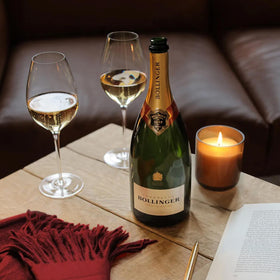
Whats the perfect glass for fizz?
Google “what is the best glass for Champagne” and a whole host of articles come up. Most of us expect to be served and indeed choose to pour our own fizz into the Champagne flutes which have become familiar. A sign of sophistication and indulgence, the images of champagne flutes at events and parties just give a little hint of glamour to the bearer - an aspect of theatre to the whole performance of enjoying champagne.
The consensus among many is that these flutes are the best type of glass to enjoy champagne at its best. The tall sides help to maintain its ‘mousse’ — or sparkle — and you want it to be fine, delicate and persistent. The narrow rim prevents excessive amounts of oxidation, helping to preserve the flavour for longer, and the long stem allows the glass to be held without heat from the fingers transferring to the juice in the glass.
It is for this reason the shallow open coupe glasses favoured in the heady opulence of the 80s have fallen out of favour to the flute, although still favoured for showpieces at weddings and events.
Legend has it the shape of the coupe was modelled on the breast of Marie Antoinette, but the glass was designed especially for sparkling wine and champagne in England in 1663.
It was fashionable right from its introduction until the 1970s-80s and the "champagne towers" showpieces were created by stacking coupes in pyramidal forms. Champagne is continuously poured into the top glass; as it overflowed, it trickled down to fill every glass below.
The Champagne coupe or “saucer” was perfect for the sweeter style of Champagne favoured in the early 20th century. However it simply does not capture the qualities of today’s drier styles. The shallow bowl means that bubbles do not develop so much and the broad surface area of the mouth causes the champagne to lose its carbonation more quickly, a shame when you consider the time, effort, craft and experience that goes into creating those bubbles!
Hence why shallow open glasses have, over time, given way to the taller, narrower flute, today’s icon of luxury and class in which the drink is now commonly served. A rough bead at the base of the flute causes bubbles to congregate and then quickly rise to the top of the glass. The bubbles capture and rapidly delivering lots of flavour and aroma, while also being visually impressive. However, there are flutes and there are “flutes” – straight sided styles or “cone” shaped glasses or the more “tulip” shaped style.
The straight-sided or cone shaped glasses arguably still allow much of the precious sparkle to escape more easily and the aromas cannot develop fully because of the restricted air movement in the narrow sides.
The tulip shape is similar to a flute but with greater bowl space, a slim base opening to a wider bowl which then narrows slightly towards the opening. The wider bowl is beneficial as it allows a little more room for aeration of the wine, and therefore allows greater development of flavours and aromatics. The narrowing towards the rim also captures and preserves the aromas in the glass and focuses them more towards the nose. Similarly to a flute, a tulip shaped glass will develop and maintain lots of bubbles, but having a wider aperture means that the bubbles will end up hitting the right regions on your tongue rather than ending up in your nose. For a good quality more mature champagne, the tulip shape could be considered to present the qualities of the juice more effectively and therefore a better choice.
However now some experts are suggesting that champagne drinkers should ditch flutes in favour of nothing more special than an ordinary wine glass – especially for high end, vintage aged Champagnes.
Frederico Lleonart, global wine ambassador for drinks giant Pernod Ricard, says that whilst simpler sparkling wines (such as prosecco or cava) should be served in flutes to keep the drink colder for longer and to show off the bubbles better, mature and complex champagnes would be best served in a wine glass. They have a larger bowl narrowing to a smaller rim, so hang on to the bubbles and capture the aroma at the top of the glass while allowing for aeration of the drink.
The brands themselves often create their own glassware and noting seems more luxurious than to sip your favourite brand of the world’s most expensive drink than to enjoy it in glassware bearing the name of and created especially for your choice of fizz. However nothing quite compares to the most unusual glass we have come across, the most eccentric yet utterly brilliant Champagne Tankard from Pol Roger.
It was said that their most famous devotee, Sir Winston Churchill, famously enjoyed his vintage Pol Roger champagne from a silver tankard allegedly consuming 42,000 bottles of the fizz over his lifetime.
The Champagne house has partnered with fellow Royal Warrant holders John Jenkins Fine Glassware to create a bespoke Champagne tankard inspired by an antique crystal glass dating back to 1785; made in the same style as Silver Tankards of the 17th and 18th centuries, very few of these antique crystal tankards have survived. The Pol Roger Champagne Tankard sees a resurrection of this lost style, handmade by skilled craftsmen at John Jenkins, the royal family’s crystal supplier.
This beautiful glass, which is engraved by hand on the base, serves as a fitting tribute to the man and his champagne, the design of the handle, which is thicker at the top and narrower at the base with a small flourish at the lower end, is typical of silver tankards of the early Georgian period. The horizontal “beading” around the body of the tankard is also a design detail taken from tankards of that time.
Churchill is legendary for being the character he was and nothing screams character as much as going against the “norm” or what the experts say.
So in conclusion, perhaps the best way to enjoy your champagne is as you want to, in a glass that you like. As long as it is clean, rinsed free of detergents, dried completely and free from scratches or cracks, and the fizz is served at its optimum temperature, sit back and enjoy. And as Churchill himself said:
“My tastes are simple: I am easily satisfied with the best.”
That’s good enough for us!

